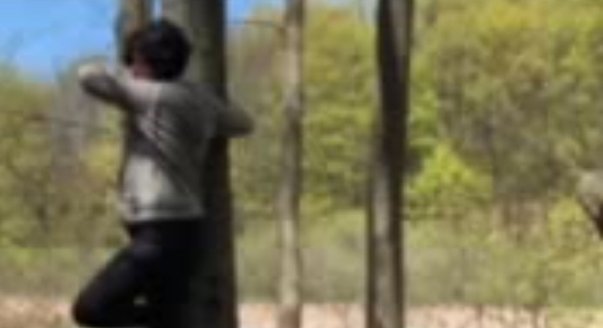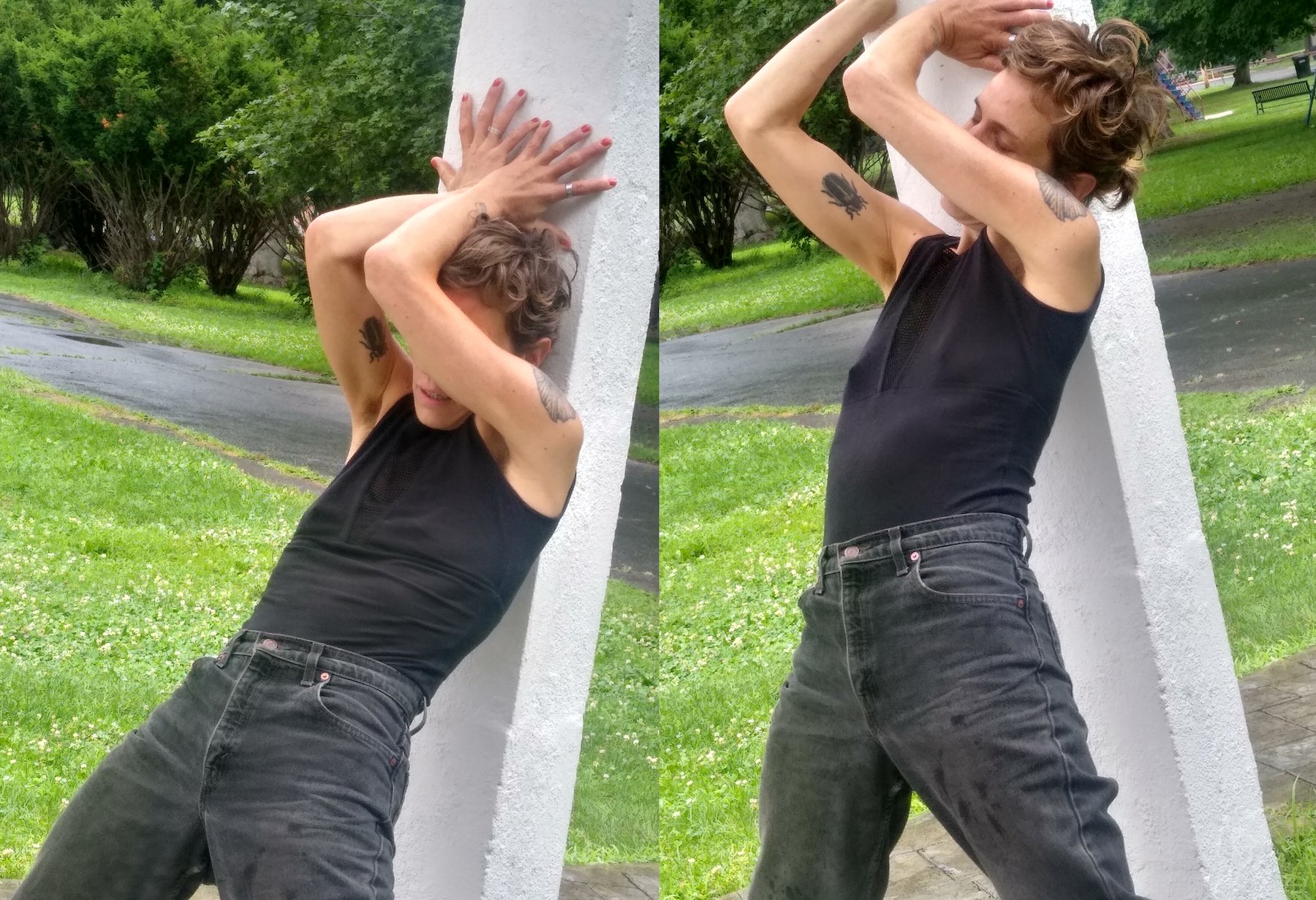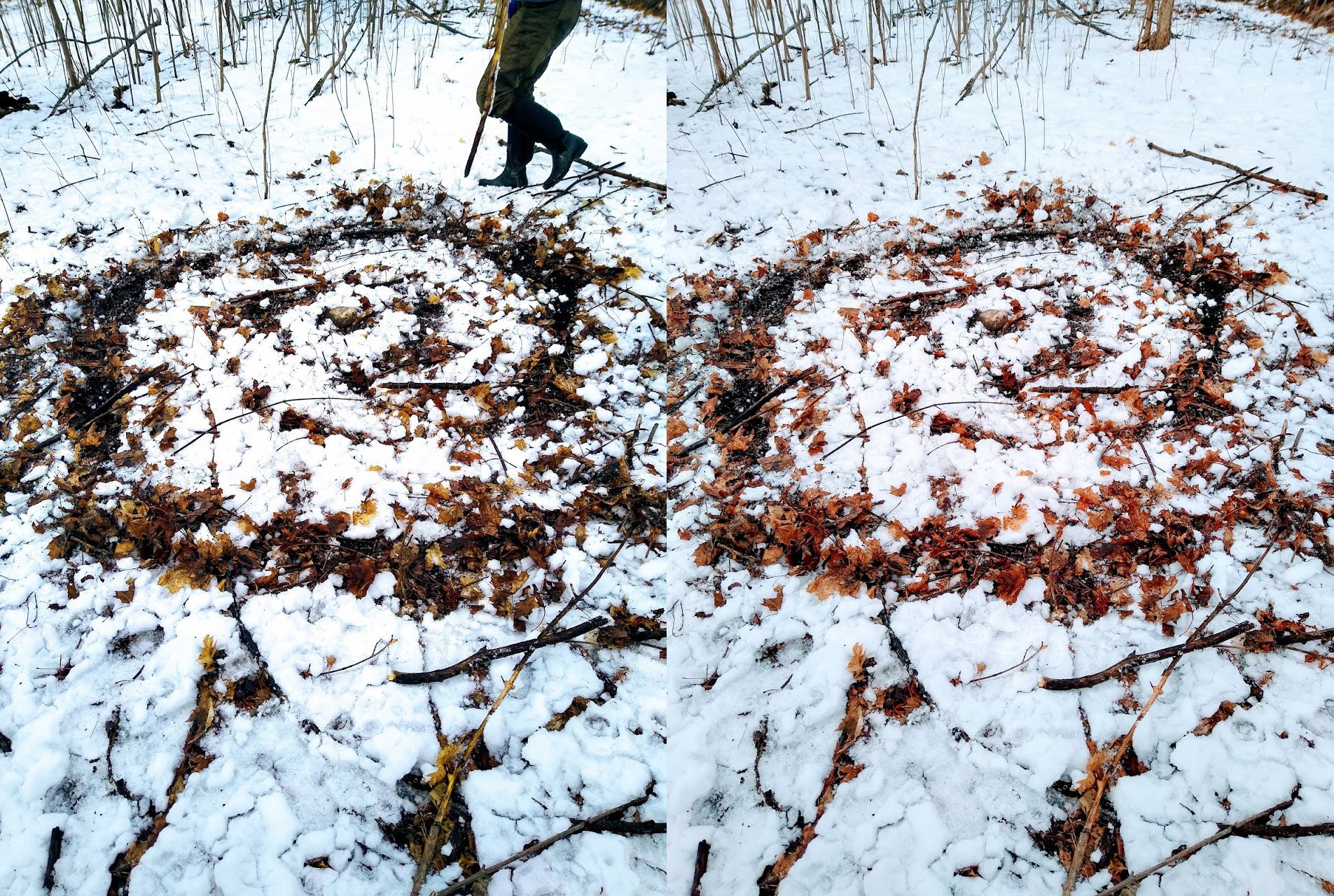Erin Sickler and Hana van der Kolk
Hana van der Kolk: The question that you proposed for this conversation was: what is it we think we're doing when we do these practices? The practice is that we get together, usually we walk somewhere; we check in—about our bodies, our hearts, stuff going on in the world, things we're thinking about in our creative practices—and we walk. Then we pick a location, usually one of three locations in the woods near where I live. We conduct some spontaneous simultaneous movement, then each one of us moves while the other one witnesses; we free write, and then we often share our writing by reading it aloud.
I think there are many layers to what we're doing. There's improvising movement. There's the practice of being in/with place, because we do these sessions outdoors and over and over in the same places in Troy, NY.
It’s also a witnessing practice—or as we say, a witHnessing practice. When I'm witHnessing you I am not—and this is related to what's trademarked as Authentic Movement by Janet Adler, a student of Mary Starks Whitehouse—interpreting or judging what you're doing, or assuming how your movements might feel to you. Instead, I'm trying to let you, your movements, your presence just be the thing that's washing over me and inviting me into presence with myself and this place as well. I think when I'm in the mover role, there's a significant effort towards a witHnessing too, towards being WITH without trying to control, being WITH what's unfolding rather than being sure I know, and resisting the move to reconcile or fix any presence of dissonance, like learning to dance WITH dissonance, rather than needing things to be harmonious.
Erin Sickler: I like how you say that witHnessing is an effort because I see, in both witnessing and moving, a tarrying between judgment and acceptance. That is so much of the practice for me. This discernment--"Is that an 'interesting' movement?" "Is that a 'good' movement?"--contains for me a bodily anxiety, one that I often project outward on other people. That's a big part of the practice for me, is seeing how much that anxiety drives the way that I interact with others.
HvdK: I remember you saying something about that when we first talked about having this conversation, that working with judgment is such a big part of the practice. I think that speaks to a core reason that I come back to improvising movement—whether it's as a teacher or as someone doing a practice like this with you, as a performer—because improvisation forces me to work with judgment and the inhibition and anxiety produced by judgment and that feels worthwhile. Not just for myself but for the world around me.
ES: Is it your term, witHnessing?
HvdK: I think I initially borrowed it from Bayo Akomolafe and my friend Sara Jane Stoner also uses it. She and I have an ongoing conversation about witHnessing, in which we’re wondering about how witHnessing could be set apart from simply witnessing as another kind of showing up in difference without separability (I borrow that idea from Denise Ferriera da Silva).
ES: It's a beautiful word, and idea. Because the movement we witHness/are witHnessed in is improvised, I always know that I can show up. I have a confidence in that kind of improvisation, whether that be on the page or showing up in my body. But sometimes improvising and free writing aren’t enough. Sometimes I just want a finished, polished thing. Maybe that's just the pressure that I put on myself that I need to finish things and share them with an audience of some form. It brings up that question of who is this for? What is this form? Does it require an audience to complete itself? That is also part of the tension that has built as we’ve done this practice over the past couple of years.
HvdK: There's a bunch of threads there that I want to explore. One is this question of recognition, the desire to be recognized. I've been wondering about the importance of recognition, but also about practice beyond or without recognition, or maybe a practice in which the field of recognition is quite small or even non-human, or else recognition that happens over a much longer time frame than a show or reading, for example.
Also, there’s this desire for form or some shareable object that might be an impulse outside of simply recognition. What is the satisfaction in form and/or completion in and of itself?
ES: In terms of recognition, for me, being surrounded by so many creative people—like authors, authors of their own work, whatever that means—and then not asserting myself as an author of my own work can feel sometimes like a form of repression.
HvdK: I think that recognition within a given community can be a way to interrupt always having one’s subjectivity exist only in relation to the dominant culture. This past summer I did a couple performances with Erica Dawn Lyle—one at a party and one at Clouds Gathering, a multi-day gathering for people engaged in a range of somatic//creative/intimacy practices—and feeling recognized in those contexts felt like hearing: "I see that you're up to something and it is in dialogue with or igniting something in my something." I think that kind of recognition within community has the potential to move us beyond where we thought we were at. It’s like, I can and need to keep going because connection is made here, there's interest, and stamina and new portals are going to open through that kind of recognition.
That kind of recognition is potent energy exchange; is moving energy. If we think about this not only in terms of an art object, but in terms of energy movement, energy work, then it's very important to be recognized. So, maybe what we're doing with this practice is doing magic (laughter). And maybe doing magic means not necessarily knowing what the merits of the practice are. I think there is a huge element of surrendering to not knowing in this way of orienting. It’s a process of becoming sensitive for the sake of becoming sensitive, of being curious and critical of ourselves in, you know, a loving way, and continuing to learn what it is to witHness ourselves and each other and land, to maybe be an embodiment of utopia’s stamina (I borrow that from Bernadette Mayer).
ES: Yes, in Buddhism, the merits of the practice are also not to be confused with the practice itself. It's not about getting a gold star for being the best at practicing, but about how that translates to being in the world. In all spiritual practice, I think this is true. It's easy to get confused and want the gold star for being the best practitioner. Which leads me to the question: what capacities are we growing for the world at large within this practice?
I feel unskilled at how to archive this practice, or many of the ephemeral things I do, in a more rigorous or nuanced way that then produces an object that one can offer others. Often, it is painful to go back to an archive that feels inadequate to the memory of the experience.
My friend Emily Wick does a lot of art that revolves around practices. They all have something to do with light. In the month of February, she only lives by daylight and candlelight. For a year and a half, she has gone outevery night and made these big soap bubbles and photographed them. Because of the way they reflect light, they look like nebulas. They're iridescent and glow all different kinds of colors.
But I have a hard time being really into something in that all-the-way way, without wondering "What am I doing? Am I wasting my time?" I tend to step back, look at it from the outside, and judge it.
You often call this a psychic practice. How do you distinguish between that and a bodily practice?
HvdK: I used to think of the psychic practices—which started in COVID for me—as just the ones I was doing with people remotely (with Tomislav Feller, Lailye Weidman, Julia Handschuh and taisha Paggett). We call each other; we decide on a score and identify the interests and ideas we want to bring forward through our practice; we hang up and do the practice (a combination of improvised moving, witnessing each other psychically, writing, image-making); maybe we send each other some writing or an image at the end; and we just practice being in the possibility—without worrying about being successful—that we're psychically connected, psychically dancing together, witHnessing each other, moving our ideas together.
Then lately I've come to think that similar practices that I do in-person feel part of the same collection of collaborations and so, I'm conceiving of all of them as “psychic practices.” All of them—in person and remote—are about love, about friendship, about attending to place and thinking weirdly through our bodies in relation and processing the unimaginable that is living in these end times together. In both cases, we are going to our bodies/beings with a curious unknowing and that opens different potentials of interconnection with another body/being without even touching, (not to mention connection with ancestors and the beings, unseen and seen, in the places where we practice). To separate the “remote” and “in-person” practices feels like adhering to a false binary between the material and immaterial. And even this idea of going in and that allows connection out feels to binary for me, too locked in an idea of the bounded individual or cause and effect.
ES: One thing I am aware of when I'm watching you is the precision and level of commitment that you've made to knowing the sensations of your body on a very subtle level, because you are a dancer. That commitment allows someone like me to step into the practice and feel like we are doing something. I see this—for lack of a better term—embodied knowledge in you, in the way that you move your body. That is something that I have a probably stronger connection to than a lot of people, but I know it's not as developed in me as it is in you.
I was just working with an artist. She did a couple of video projects that had to do with a children’s play called “Rubber Band Play'' in Korea, known in the United States as “Chinese Jump Rope.” In an early version she worked with non-dancers, but later she was later able to do it with former Merce Cunningham dancers. She told me how important it was for her to work with them because of the technique they hold in their bodies. Honestly, it takes some humility to show up and practice every day to get that kind of mastery. It's funny that it's called mastery because it's really like being in submission to the practice or learning, being the student. I guess that's cliché, being a lifelong student or whatever.
HvdK: Yeah. Totally. I think I'm only enamored with any art world/dance world, inasmuch as it facilitates rigor and completion. That's what keeps me coming back and not just completely breaking from it and being like these are just my personal practices. It keeps me coming back to certain contexts. I mean, now and then, someone really pushes these types of practices into “completion” in an interesting way and it really is so awesome. That's my experience of writing with you. I feel maybe your technique or just experience with working with writing, your practice, activates a kind of aspiration in me and there's a pleasant energy to aspiration sometimes.
ES: And, perhaps similarly, dancing with you is healing for me. When I was dancing while growing up I was often told, "You don't have a dancer's body" and “you can't…” But dance brings me an exuberant joy; it is something that I care a lot about and have always cared about, so our practice is healing for me in that I can admit that I care about this thing.
HvdK: Right, and maybe that care and healing will speak to someone else somehow. I’ve been wondering if this depth of intimacy that I've been building with all these psychic practices could be the very place where I step up to something new in terms of completion because now I have these practices and relationships that have a lot of depth and integrity. Maybe I can ask these people and the spaces we create together to be the very spaces that hold me differently accountable to finishing something or going deeper with something, in a way that’s more supportive than, "You should make a show.”
ES: Yeah. I like that. And something that resonates for me, and I think both of us, is that neither of us are taken by the kind of sheen of the art world, the glamor, the prestige, the finished product alone. We are much more interested in the process.
Erin Marie Siclkler’s related links: Instagram
Hana van der Kolk’s related links: Instagram / website
All images above courtesy of Erin Marie Sickler and Hana van der Kolk
Erin Sickler is a curator, writer, and lifelong mover. She received her BA in Art and Environmental Studies from Oberlin College and an interdisciplinary MA at NYU. Positions include Gallery Manager of the Esther Massry Gallery at the College of Saint Rose in Albany, NY; Director of Curatorial Programs at 601Artspace, New York, NY; and Assistant Curator at the Queens Museum, Queens, NY. She is currently Studio Director for the artist Randy Polumbo. Independently curated exhibitions include Mutadis Mutandis: Signo, Símbolo, Icono (Uno Caña, Mexico City), exhaust (Contemporary Art Tasmania, Hobart), and Prolonged Engagement (EFA Project Space, New York). Her art writing has appeared in Art in America, Artlink (AUS), The Brooklyn Rail, October, and numerous blogs and catalogs. Her poetry has been published in The Brooklyn Rail and as part of artist Freya Powell’s collection The Mnemosyne Atlas 2012. Residencies for non-fiction writing include Millay Colony, Austerlitz, NY and the Broken Hill Art Exchange in Broken Hill, Australia.
I'm Hana van der Kolk (pronouns any and all). I see dance as a conduit for knowing/unknowing what is here and now, for remembering intimacy at any proximity. I'm interested in leaning towards the uncanny, the messy and the boring in that process. Based on Mohican territory (Troy, NY), I am tending land and community. I am also often in Amsterdam (NL), was based in Los Angeles for years, and have taught/performed in many places and kinds of containers. I am nearing the end of a practice-based PhD with a collection of practices, a video piece and written dissertation titled Utopia's Stamina (which I borrow from Bernadette Mayer). I hope they will be nourishing offerings! I love my dog, my friends, the forest and all shades of pink and gold.


